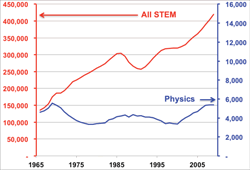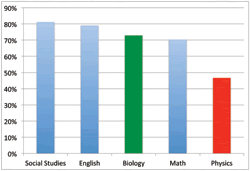The Economics of Education: Closing Undergraduate Physics Programs
By Theodore Hodapp



- 49% of all public institutions
- 58% of all institutions
- 100% of all public Historically Black Colleges and Universities (HBCUs) (and all but two of the private HBCUs)
These are the percentages1 of undergraduate physics programs that would be closed if the recently enacted standards in Texas are applied throughout the country. One might write this off as Texas politics, but similar measures are already in progress or being considered in California, Florida, Idaho, Louisiana, Maine, Mississippi, Missouri, and Tennessee–and there are undoubtedly others we have not heard from. Physics programs around the country are under attack.
What was the criterion used? For an undergraduate program to survive, it must graduate 5 majors per year averaged over the past five years. The reality is that universities have been hit hard with budget cuts and state officials are looking for ways to slice off whole programs in a draconian attempt to either save money or at least be seen as saving money.
Why 5? In some cases the number has been even larger, and there is no indication from places like Texas that 5 is the ultimate goal. The real answer is that no one seems to know, but for now 5 is a commonly used number, although 10 or even 15 graduates per year may be where things are heading.
It is also nothing new to consider closing (or opening) smaller programs. The American Institute of Physics (AIP) Statistical Research Center reports that on average three programs close in any given year, and about the same number open. Over the past decade the number of baccalaureate physics programs has been relatively constant at around 760. What is disconcerting in this new calculus of survival is that, according to data from the National Center for Educational Statistics, 58% of all physics programs fail to meet the 5/year mark. At 10/year the number rises to 94% of all programs, eliminating 71% of all physics bachelor’s. Astronomy is even worse off, with 70% of the 82 departments in the US educating fewer than 5 majors per year, and only two of the remaining departments educating more than 10 annually.
These recent decisions in a number of states indicate that the era, if it ever existed, of a program existing because it is unthinkable not to offer physics is over. Dominating the current academic landscape are huge numbers of business, psychology, communications, and life-sciences majors. Physics undergraduate degrees accounted for 0.88%2 of all majors in 1966. Now they account for 0.32%. Figure 1 shows how physics has fared compared to the aggregate STEM (Science, Technology, Engineering and Mathematics) fields. The total number of physics graduates is roughly the same as it was in the late 60’s at around 6,000, but as a fraction of the undergraduate degrees it has fallen by almost a factor of three from its former standing. Further, if you normalize the data to the US population, which increases at roughly 1% per year, the data indicate that other majors have successfully lured away students who previously would have majored in physics. As a colleague recently said to me, “Who is better equipped to deal with the challenging problems that currently face our society–physics or psychology majors?” Psychology graduates increased from roughly 17,000 to 100,000 in those same four and half decades.
The problem of low numbers of physics majors is inextricably related to another significant issue–the profound shortage of highly qualified secondary physics teachers. Figure 2 shows that less than half of all high school physics classes are taught by a teacher with a degree in physics. While it is clear that knowing the content does not a great teacher make, it is an essential prerequisite. If we expect students coming into our physics departments to be excited about the opportunity to study physics, it is essential that they have the opportunity to take physics from a highly qualified teacher–something still unavailable to many students in the US.
Nor is this issue confined to the US. Director of Education and Science at the UK’s Institute of Physics, Peter Main, reports3 that the number of institutions that offered physics degrees fell by about 30% in only 10 years from 1994 to 2004. In roughly the same time period the number of students accepted into teacher training programs in physics fell by almost half.
Did you know that only about one in seven of all undergraduate physics majors will go on to receive a PhD in physics? Ask yourself: Is the physics major at my department appropriate for educating future high school physics teachers, or mostly for funneling students into graduate programs? Often the number of students who go on to graduate school is quoted among chairs who are extolling the strength of their department. Do you know how many of your majors go on to teach physics in high school? Shouldn’t you be quoting this number too?
Ask your undergraduate majors why they decided to study physics in the first place. By far the most common answer I get when asking students in departments across the country is: I had a great high school physics teacher! What do you suppose physics would look like if everyone had that opportunity?
The Response
So what is to be done? One thing is certain: waiting until your dean, provost, or president (or state agency, as in many of the reports we are hearing now) gets involved probably means you are already too late. If your department is known to be addressing the issue, getting results, and being proactive, you have a better chance at convincing the powers-that-be that you are serious about understanding the concerns and taking significant steps to meet the challenge.
Fortunately, there are a number of success stories at a variety of types and sizes of institutions. The most comprehensive study, with recommendations on this issue, is the SPIN-UP report4 (Strategic Programs for Innovations in Undergraduate Physics), the outcome of a multi-year study of physics departments that were increasing their number of graduates at a time when enrollments were declining. The report, a joint effort by APS, AIP, and the American Association of Physics Teachers, is worth reading in its entirety to understand the many details of how programs beat the downward trend. Among the findings, the report characterized common elements found in thriving departments:
- A supportive, encouraging, and challenging environment for both faculty and students characterized by professional and personal interactions among faculty and students
- Energetic and sustained departmental leadership focused on a vision of an excellent undergraduate physics program
- A sense of constant experimentation with and evaluation of the undergraduate physics program to improve physics teaching, undergraduate research, student recruitment and advising
Particular issues identified at thriving institutions included: improving the introductory course sequence; active recruiting, advising, and career mentoring; providing flexible major tracks; mentoring of new faculty, especially in teaching; and an active undergraduate research program. At successful institutions there was a confluence of effort rather than a single program that contributed to a vibrant community of students learning physics. Read this report!
Educating high school physics teachers, mentioned in SPIN-UP, is also a critical element of success for any department that recruits a substantial number of their majors from the surrounding area (this includes most departments). This is a long-term strategy, but, given the inspiration so many students have gotten from great teachers, it is a clear winner for attracting students to physics. The PhysTEC project5 has more than a decade of experience in helping departments find ways to educate more teachers. Some steps to consider include:
- establish and advertise a separate physics major track in physics secondary education
- make sure all faculty who advise undergraduates are aware of guidelines and recommended courses for future teachers
- contact your education department to find out how to track recent grads who are now teaching, and contact them to hear their experience in becoming a teacher at your institution
- consider establishing a “learning assistants” program6 to give students a taste of what it is like to teach
- attend the annual PhysTEC conference7 to meet leaders in the field of high school physics teacher education
- know your local physics high school teachers, and make sure they know you: developing those relationships will pay big dividends
Another strategy that has proven extremely important is improving the introductory course. You can recruit students all you want, but if they get a bad taste in their mouth in your Physics 101 course, you will lose them–and all of your hard work in bringing them in the door. What is more, many students “find” their way to the discipline through this course. Putting your best foot forward is essential.
Consider implementing an active learning curriculum like SCALE-UP8 or Tutorials in Introductory Physics.9 These activity-based approaches to physics have demonstrated improved learning gains. SCALE-UP has also demonstrated a decrease in the drop/fail/withdrawal rate at a variety of institutions. An improved curriculum is not the only answer, but having research-tested materials, your best educators, and an opportunity for these instructors to learn how to use the materials effectively, will go a long way toward improving the situation.
Finally, and probably most importantly, undergraduate programs that do well, do so by paying attention to their students. Understanding their goals, and the challenges and context they bring to learning will help you understand how to provide appropriate advice and mentoring. Advising that is limited to “signing off” on their choice of courses will not allow you to intervene when needed, or let them know you care about their progress. That degree of empathy not only helps them, but it builds a stronger program, and more committed students.
The Challenge
Like many, I chose physics because it gave me a perspective that is empowering and powerful. I don’t want everyone to become a physicist, but I do want everyone to have the opportunity to study the subject and learn why and how science, and physics in particular, provides that potent perspective.
If we do not take action, many of the programs that offer physics may be closed, and many students who do not choose physics initially, but instead happen upon it will never have the chance to enjoy the subject. Even more important, we will continue to fail to educate an adequate number of high school teachers who provide the first glimpse of the subject and its power to future generations.
The challenge is to be proactive in shaping a continually improving undergraduate program, building a cohesive student/faculty community, and actively recruiting promising students to that program.
If you graduate fewer than 10 majors each year, this means you!
Theodore Hodapp is Director of Education and Diversity for the American Physical Society. Prior to joining the APS, he was professor and chair of physics at Hamline University in St. Paul, MN. For more information, links, resources, and case studies of successful programs, visit www.aps.org/link/recruitingmajors
1.Based on 2005-2009 graduation rates reported in the NCES Integrated Postsecondary Education Data System (IPEDS); 2.IPEDS data; 3.Personal communication; 4.The report is available at www.aps.org/link/spinup; 5.Physics Teacher Education Coalition (www.phystec.org); 6.laprogram.colorado.edu; 7.www.ptec.org/conferences; 8.www.ncsu.edu/PER/scaleup.html; 9.www.phys.washington.edu/groups/peg/tut.html
©1995 - 2024, AMERICAN PHYSICAL SOCIETY
APS encourages the redistribution of the materials included in this newspaper provided that attribution to the source is noted and the materials are not truncated or changed.
Editor: Alan Chodos
December 2011 (Volume 20, Number 11)
Articles in this Issue

